Key takeaways:
- Understanding sleep cycles and the importance of a consistent sleep schedule greatly improved overall well-being and productivity.
- Creating a sleep-friendly environment, including reducing light and noise, and maintaining good air quality significantly enhanced sleep quality.
- Monitoring and adjusting habits, such as limiting screen time and being mindful of caffeine intake, led to valuable insights and long-term improvements in sleep health.
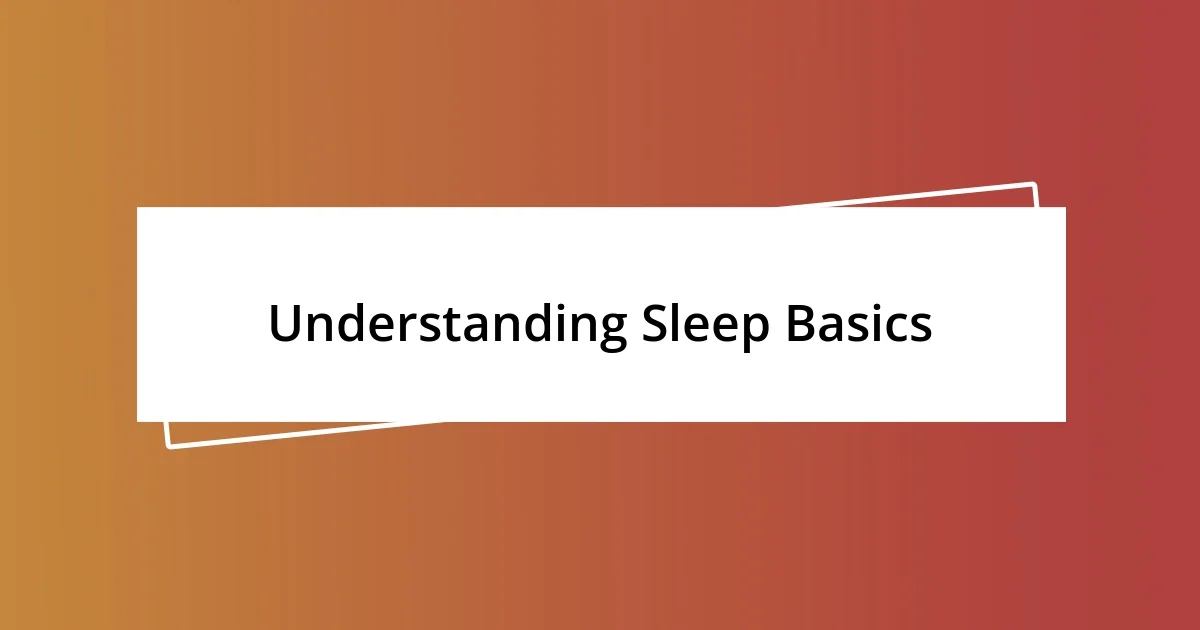
Understanding Sleep Basics
Sleep is an intricate process that our bodies rely on for physical and mental restoration. I remember when I first learned that sleep cycles consist of various stages, including REM (Rapid Eye Movement) sleep, where dreaming occurs. Each stage plays a crucial role in how well-rested we feel; have you ever noticed how a poor night’s sleep can leave you feeling foggy and irritable the next day?
Understanding that our bodies follow a natural circadian rhythm helped me appreciate how deeply connected sleep is to our overall health. I’ve felt the difference when I shifted my bedtime to align better with sunrise. It’s astonishing how a slight change can influence not just how I feel in the morning but also my productivity throughout the day.
Did you know that adults typically need 7 to 9 hours of sleep for optimal performance? I used to think I could thrive on less, but reality hit when I started napping during the day due to sheer fatigue. The way our sleep patterns affect our mood reminds me that sacrificing sleep isn’t just about missing out on rest—it’s about losing valuable emotional balance too.
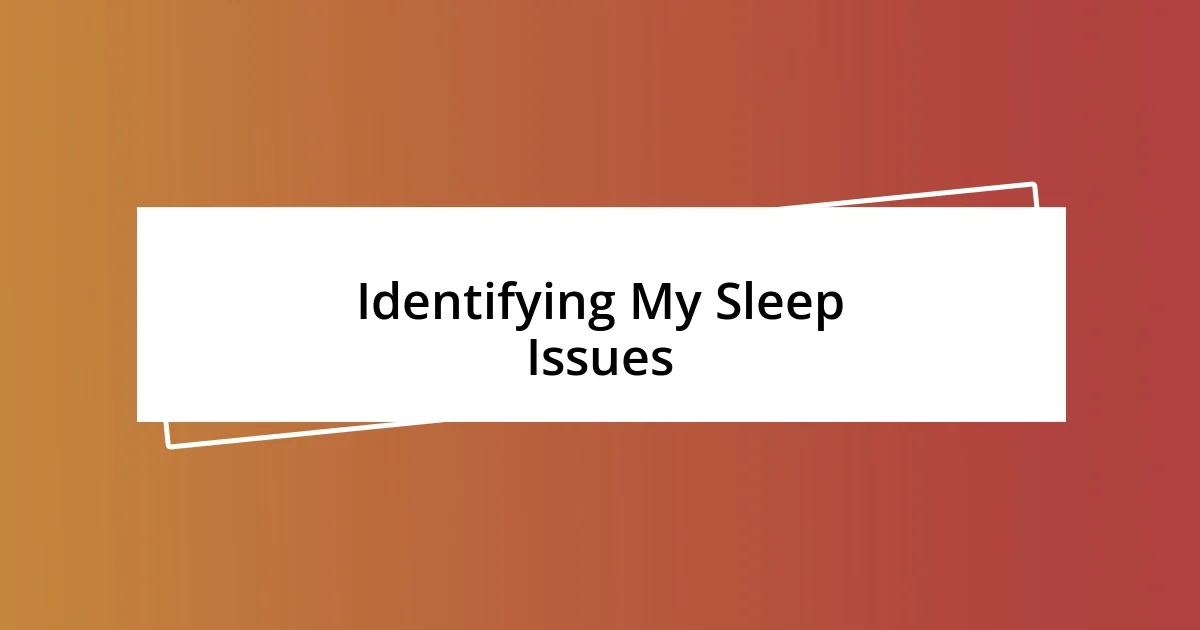
Identifying My Sleep Issues
Identifying sleep issues often feels like a complex puzzle, one I was determined to solve. In my case, I started by tracking my sleep patterns and taking note of how I felt each day. I realized that restless nights were usually preceded by late caffeine consumption or screen time close to bedtime. It’s funny how those seemingly small choices echoed through my entire day, leaving me fatigued and emotionally drained.
- Difficulty falling asleep at night
- Waking up multiple times during the night
- Feeling tired upon waking
- Experiencing vivid dreams or nightmares
- Napping excessively during the day
- Struggling to concentrate at work or during daily tasks
The more I reflected on these challenges, the clearer it became that my environment played a significant role, too. For instance, I often found my room too bright from outside streetlights or too cluttered to feel calming. Simply understanding these sleep issues allowed me to take actionable steps—like investing in blackout curtains or decluttering my nightstand—that transformed my sleep experience.
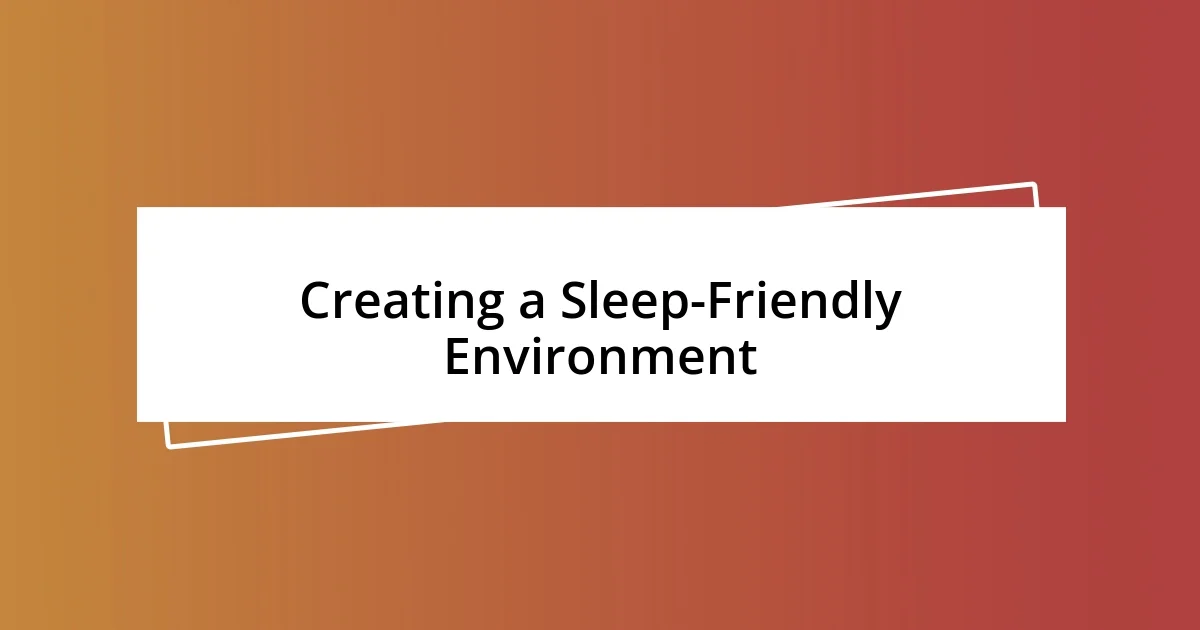
Creating a Sleep-Friendly Environment
Creating a sleep-friendly environment was a game-changer for me. I remember when I finally invested in blackout curtains; it felt almost surreal how much darkness contributed to my ability to sleep soundly. It’s hard to believe something so straightforward could have such a profound effect, yet I woke up feeling more refreshed and ready to tackle the day, as though I’d been gifted extra hours of restorative rest.
The noise level in my space also played a crucial role. After I placed a white noise machine near my bedside, I noticed a significant drop in my restlessness during the night. I had previously underestimated how distracting those random clattering sounds could be. Creating a calm atmosphere really involved addressing these smaller yet impactful details, like reducing clutter and using calming colors for bedding. I’ve found that a serene visual environment can signal my brain that it’s time to unwind, encouraging a more peaceful transition into sleep.
Some people think that air quality doesn’t matter much, but I’ve learned the opposite over the years. Keeping my bedroom well-ventilated with a gentle breeze not only helps me breathe easier but also promotes a comfortable temperature that makes it easy to drift off. I’m now a firm believer that every little aspect contributes to the bigger picture of a restful night.
| Aspect | Impact |
|---|---|
| Lighting | Darkness promotes melatonin production, aiding in falling asleep faster. |
| Noise | White noise can mask distractions, leading to uninterrupted sleep cycles. |
| Clutter | A tidy space creates a calming environment that encourages relaxation. |
| Air Quality | Good ventilation and comfortable temperature enhance overall sleep quality. |
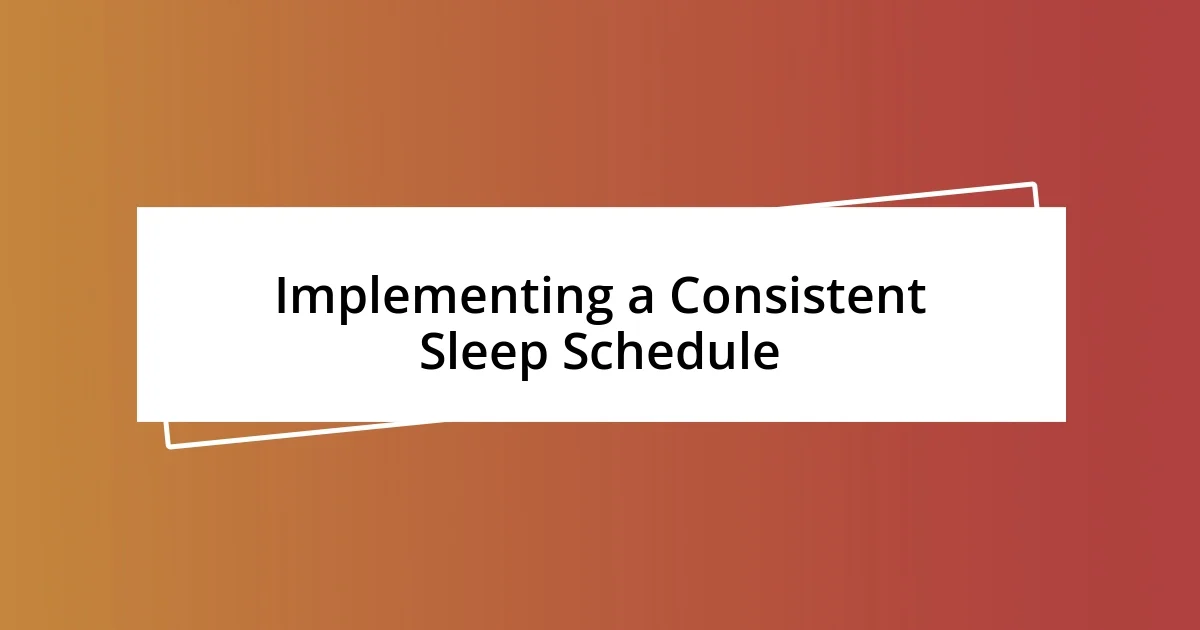
Implementing a Consistent Sleep Schedule
Establishing a consistent sleep schedule turned out to be a cornerstone in my journey to better rest. I started by setting a specific bedtime, and honestly, at first, it felt restrictive, like an old school bell ringing for recess. But over time, I noticed that my body began to cooperate with this schedule, making it easier to drift off at night. Have you ever noticed how a consistent wake-up time can make mornings feel much more manageable?
Finding a rhythm was about more than just the numbers on a clock—it also required a level of self-discipline I didn’t expect. I remember a time when I was tempted to binge-watch shows late into the night. The thrill of the story kept me awake, but when I finally gave in and went to bed late repeatedly, my mood the next day was dismal. I had to learn the hard way that these late-night escapades led to grogginess and irritability. Developing a bedtime routine that signaled my body it was time to wind down—like reading or practicing relaxation exercises—made all the difference.
In my experience, even the weekends require some vigilance. I used to think that sleeping in would reward my hard work during the week, but it often left me feeling out of sync. Now, I try to keep my sleep routine fairly consistent, even on days off. Isn’t it interesting how small habits can create such a powerful impact on our lives? Embracing this steady schedule has genuinely helped me build a foundation for deeper, restorative sleep.
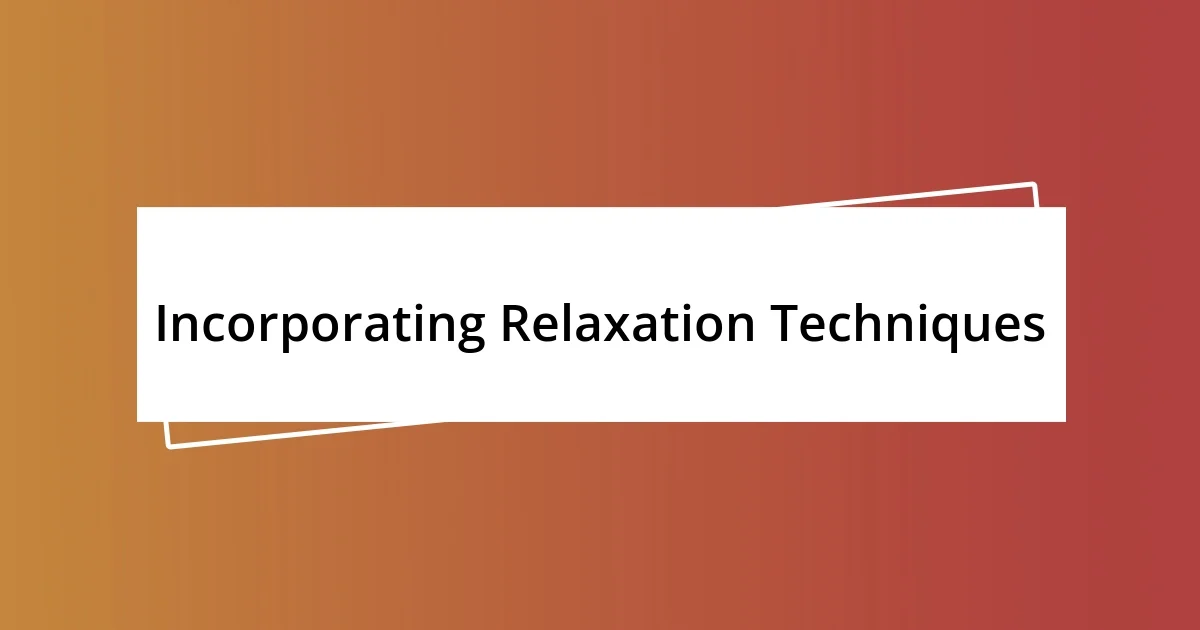
Incorporating Relaxation Techniques
Integrating relaxation techniques into my night routine opened a new door to tranquility. I still remember the first time I tried deep breathing exercises before bed—closing my eyes, inhaling deeply, and feeling the tension melt away. It was like I had discovered a secret mode of relaxation that ushered me gently into sleep. Have you ever noticed how simply focusing on your breath can quiet a racing mind?
I also incorporated gentle stretches into my pre-sleep ritual. It’s honestly refreshing to engage in movements that release the tightness accumulated throughout the day. There was one particular evening when I practiced a few yoga poses, feeling grounded and connected to my body. I was amazed at how this small commitment made a significant shift in the way I approached sleep—suddenly, my mind was no longer racing, allowing me to slip into slumber with ease.
Another technique that transformed my evenings was practicing progressive muscle relaxation. I remember lying in bed, starting with my toes and gradually working my way up to my head, consciously releasing tension in each muscle group. It’s almost meditative, and I was often surprised at how much stress I was holding onto without realizing it. I urge you to give it a try; you might find it surprisingly beneficial in calming both body and mind, paving the way for a good night’s sleep.
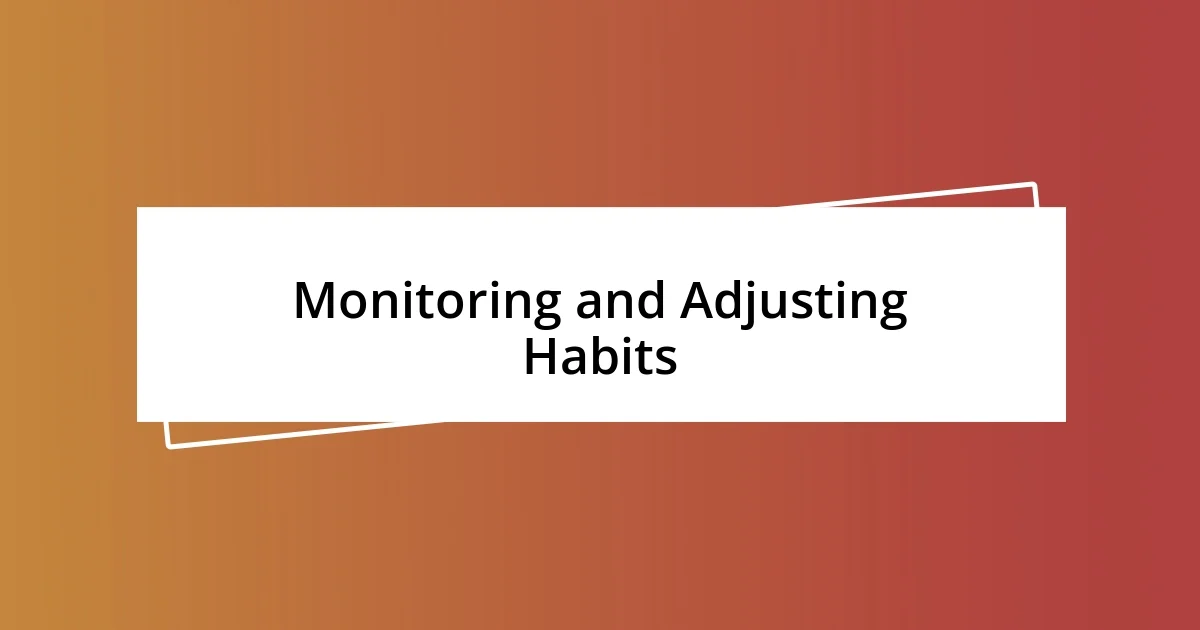
Monitoring and Adjusting Habits
Monitoring my sleep habits was a game changer in my journey toward restful nights. I started by journaling my sleep patterns, noting down the hours I fell asleep and woke up. Initially, I felt a bit silly writing it down, but as the days passed, I began to identify trends. For instance, I noticed how days filled with caffeine after 2 PM led to restless nights. Have you ever realized that a small change in your afternoon pick-me-up can ripple through your sleep cycle?
Adjusting these habits became an exploratory journey. There was one instance when I decided to limit my screen time an hour before bed. The difference was astonishing! The first night I tried it, my mind felt clearer, and my eyelids grew heavy much quicker. I hadn’t expected how much blue light from my devices could disrupt my natural rhythm. It’s really eye-opening, isn’t it? Simple adjustments can yield unexpected rewards.
Reflecting on my experience, I learned that monitoring isn’t just about noting down times—it’s about being aware of how different activities affect my rest. I remember feeling groggy one morning, and as I reviewed my sleep log, I connected the dots. That particular night, I had indulged in a spicy dinner too close to bedtime, and it disrupted my sleep. Embracing this awareness allowed me to take charge and refine my habits continually for better rest. What insights might you uncover by tracking your own patterns?

Evaluating Long-Term Results
Evaluating the long-term results of my better sleep patterns has been enlightening. After months of commitment, I noticed a profound shift in my daily energy levels and overall mood. It’s interesting how a solid night’s slumber can turn the mundane into the magical, don’t you think? I recall a particular afternoon when I felt a rush of creativity, which I now attribute to the clarity provided by consistent, quality sleep.
As I dove deeper into this journey, I began to see the lasting benefits of my previous adjustments. I once clocked an impressive six weeks of uninterrupted sleep, and that’s when I truly felt the difference. No more wake-up fog; just clear thoughts and a brighter outlook. Can you imagine waking up excited for the day instead of dreading it? These variations in my mood and productivity became clear markers of my success.
Reflecting on all this, it was vital to regularly evaluate and reassess what worked best for me. I remember one night questioning whether I could maintain my sleep improvements indefinitely—it was a bit scary! Yet, by looking back at my journey, I realized that each small change contributed to a bigger transformation. It’s fascinating how long-term evaluations can reveal not just results, but personal growth as well, wouldn’t you agree?












